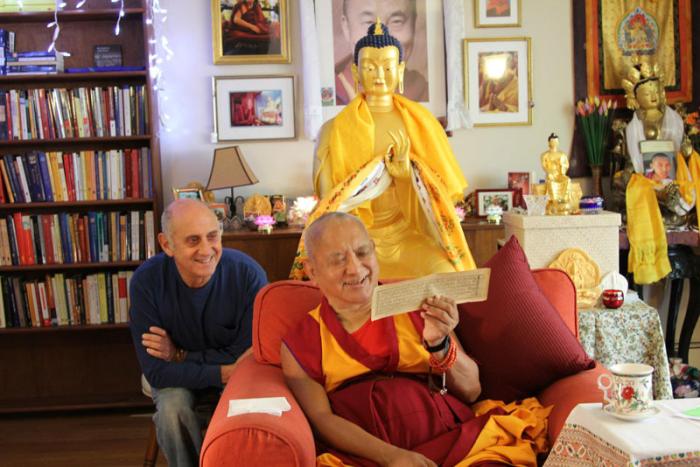Dear Friends,
We are so grateful to all of you for the amazing support you offered on last weekend on Lhabab Duchen. Together your donations totalled $10,000! As we celebrate 20 years of success in our mission to bring the precious teachings of Lama Yeshe and Lama Zopa Rinpoche to the world, this gets our annual year-end appeal off to a great start and is already 20% of our 2016 goal of $50,000. Thank you so much.
2016 Year End Appeal: A Living Archive
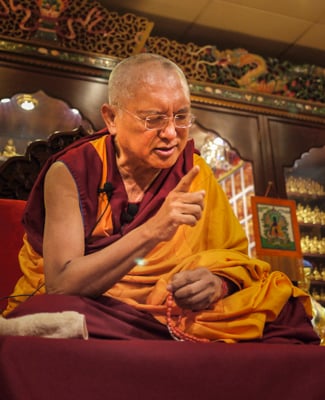 The Lama Yeshe Wisdom Archive is a living archive: ever changing, constantly expanding and always finding new ways to offer the timeless teachings it contains—both classic and contemporary—to everyone around the world, every day.
The Lama Yeshe Wisdom Archive is a living archive: ever changing, constantly expanding and always finding new ways to offer the timeless teachings it contains—both classic and contemporary—to everyone around the world, every day.
The Archive is growing all the time. We are all so blessed to have Lama Zopa Rinpoche in our midst, continuing to teach us with his impeccable example, perfect speech, boundless energy and never-ending activity for the benefit of all. Recordings of Rinpoche’s teachings are continually added to the archive and our dedicated team works daily to transcribe and edit these teachings so that they can be shared with students everywhere.
In addition to the new teachings being added, we are constantly collecting and digitizing archival video and audio recordings to add to the existing archive, such as those being added to our YouTube channel every month. Our ongoing mission—with your support—is to protect, catalog and organize this ever-expanding collection so that it remains an unfathomably precious resource into the future.
As a digital collection, the Archive is constantly evolving to take advantage of emerging technologies for storing our collection and making it available to researchers, editors and students. Last year, we updated the LYWA website to make it easier to use, simpler to navigate and more beautiful to engage with.
 And this year, together with the FPMT International Office, we are embarking on a project to implement a new system for storing, cataloging and sharing our digital collections of transcripts, audio, images and video. This new system will further safeguard our collections, facilitate our work together and ensure that the tools we are using to manage the archive are most efficient and position us well for the future.
And this year, together with the FPMT International Office, we are embarking on a project to implement a new system for storing, cataloging and sharing our digital collections of transcripts, audio, images and video. This new system will further safeguard our collections, facilitate our work together and ensure that the tools we are using to manage the archive are most efficient and position us well for the future.
For many years now we have taken advantage of every new means of making the teachings available and easy to access, such as ebooks, online audio and podcasts, and video. In recent years we have also been publishing multimedia titles, bringing to life the Archive’s varied resources of text, images, audio and video. And LYWA's vibrant presence on social media sites such as Facebook, Twitter, Instagram and Google Plus provide immediate and continuous access to the Lamas’ timeless wisdom.
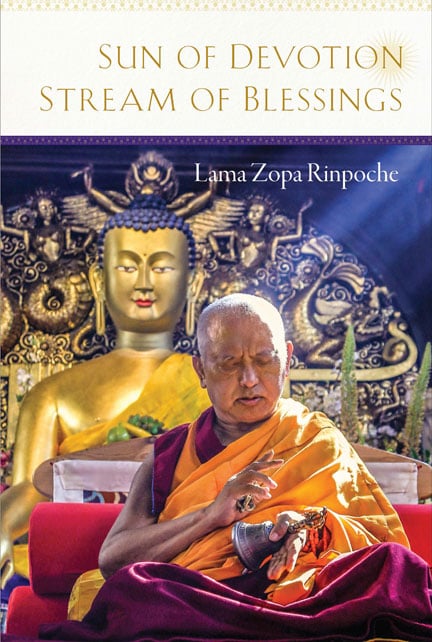 The resources in the archive range from the classic to the contemporary, from the teachings given at Kopan lam-rim courses starting from the early 1970s, to some of the very latest teachings from Lama Zopa Rinpoche, such as those published in Sun of Devotion, Stream of Blessings, Rinpoche’s complete teachings in England in 2014. The Archive is replete with teachings that are relevant no matter when they were given, such as Lama Yeshe’s teachings in Universal Love, which continue to resonate today.
The resources in the archive range from the classic to the contemporary, from the teachings given at Kopan lam-rim courses starting from the early 1970s, to some of the very latest teachings from Lama Zopa Rinpoche, such as those published in Sun of Devotion, Stream of Blessings, Rinpoche’s complete teachings in England in 2014. The Archive is replete with teachings that are relevant no matter when they were given, such as Lama Yeshe’s teachings in Universal Love, which continue to resonate today.
We invite you to be part of this living tradition. Celebrate 20 years of accomplishing our mission with your donation to the Archive. We could not do it without the support of each and every one of you. Together we bring the precious Dharma to thousands of people every day. Supporters like you are our partners in this in this amazing and beneficial work. We greatly appreciate your support as you continue to join hands with us to bring peace to the entire world.
Shop for LYWA: Why Feed Samsara?
With the holiday shopping season kicking off, you can take this opportunity to support LYWA while with a few easy clicks of the mouse. Some of you may be familiar with Amazon.com's program to support non-profit organizations, Amazon Smile. This program provides a way to have a portion of your Amazon.com purchase be offered back to the non-profit organization of your choice.
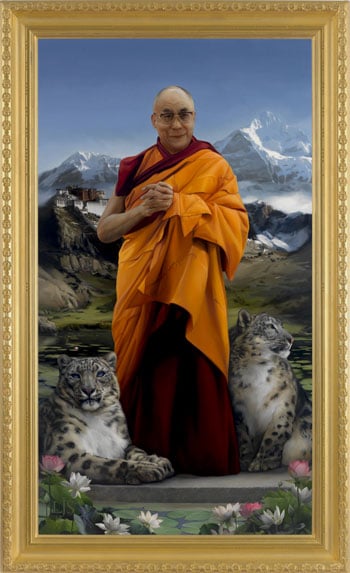 If you're on online shopper, just go to AmazonSmile to shop. The first time you visit the site, it will ask you to choose an organization. Just type in Lama Yeshe Wisdom Archive and it will find us. Now, when you shop through AmazonSmile the Archive receives 0.5% of the sale as a donation. This is an easy way to transform a worldly activity into a Dharma activity!
If you're on online shopper, just go to AmazonSmile to shop. The first time you visit the site, it will ask you to choose an organization. Just type in Lama Yeshe Wisdom Archive and it will find us. Now, when you shop through AmazonSmile the Archive receives 0.5% of the sale as a donation. This is an easy way to transform a worldly activity into a Dharma activity!
You can also consider giving a gift of Membership to a loved one, and they can receive all the benefits of Membership from this point forward. Those who can offer US$1,500 or more will receive all the usual Membership benefits plus a limited edition of Lisa Sawlit's spectacular portrait of His Holiness the Dalai Lama. The limited edition prints are 36 x 22” (91.5 x 56 cm) in size, and have been numbered, signed and sealed by the artist. [Please note: As of 2020, the portrait is no longer available.]
LYWA books also make great gifts. And remember to give a gift to yourself-- when you make a donation of $50 or more to the Archive, let us know your choice for a thank you gift!
New Advice from Lama Zopa Rinpoche
This month we have many new advices added to Lama Zopa Rinpoche's Online Advice Book, including: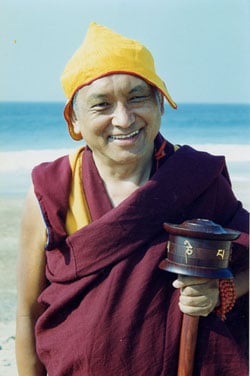
• Heartfelt Thanks For Helping the Center: In this letter to a benefactor, Rinpoche explains the benefits of helping the Dharma center. Rinpoche said this advice can be shared with others who are generous and in this way are bringing sentient beings to enlightenment.
• Practice For All Sentient Beings: Rinpoche gives this life advice to a new student.
• Benefits of Offering Food: Rinpoche had sponsored lunch on the Buddha Day for people who had taken precepts at a Dharma center. Rinpoche wrote this card to thank the center director and students for their service.
• Your Mother is Most Kind, Most Dear, Most Precious: A student wrote asking what she could do for her mother who had depression and had attempted suicide. Rinpoche gave this advice about the kindness of the mother.
You can see all the latest advices added to the Online Advice book on our website here.
News on our current book projects
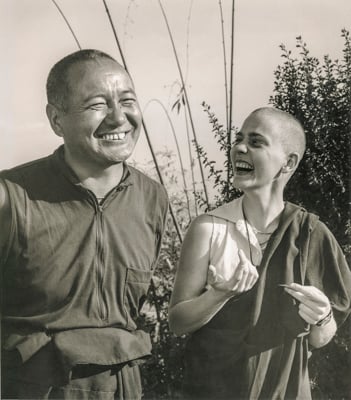 Work steadily continues on Lama Yeshe's biography Big Love. The text is essentially set but photo selection is taking time, as we consider each of the tens of thousands of photos in our historic archive (some of which you can see in our Online Image Gallery.) Without going into the details of how David Zinn, our digital imaging specialist, and I collaborate, it is painstaking work but we are doing everything we can to move it along while remaining true to doing the best job we can. Recently we have begun looking at layout possibilities with our designer, and it is exciting to get a glimpse of how the final product will look.
Work steadily continues on Lama Yeshe's biography Big Love. The text is essentially set but photo selection is taking time, as we consider each of the tens of thousands of photos in our historic archive (some of which you can see in our Online Image Gallery.) Without going into the details of how David Zinn, our digital imaging specialist, and I collaborate, it is painstaking work but we are doing everything we can to move it along while remaining true to doing the best job we can. Recently we have begun looking at layout possibilities with our designer, and it is exciting to get a glimpse of how the final product will look.
We endeavor to share with you excerpts of the book, including many of the images, as it is prepared, which you can read on our Big Love blog. We also present entire chapters of the book on our website, and most recently we completed an update of the chapter which chronicles the Lamas' activities in 1979.
As we mentioned in our Lhabab Duchen mailing, our next book is Abiding in the Retreat, a nyung nä commentary by Lama Zopa Rinpoche. As the editor, Ven Ailsa Cameron, says in her preface,
Compassion is the wish to free all living beings from suffering and its causes, and the embodiment of the compassion of all the buddhas is Chenrezig (Avalokiteshvara, in Sanskrit), the Buddha of Compassion. One of the most intensive and powerful Chenrezig practices is nyung nä, a two-day retreat that combines meditation on Thousand-Arm Chenrezig and recitation of Chenrezig’s mantra, OM MANI PADME HUM, with prostrations, fasting and silence. Abiding in the Retreat is a commentary to a nyung nä sadhana composed by Kälzang Gyatso, the Seventh Dalai Lama, according to the nyung nä lineage originating from Bhikshuni Lakshmi (Gelongma Pälmo, in Tibetan), an Indian princess who cured herself of leprosy and achieved enlightenment through nyung nä practice.
Very little commentary to nyung nä practice is available in English. As nyung nä retreats are held each year in many FPMT centers, I thought to compile a nyung nä commentary by Lama Zopa Rinpoche, Spiritual Director of the FPMT.
Therefore we are honored to be able to bring you these amazing teachings. Please see below for an excerpt on the importance of reciting OM MANI PADME HUM.
Lama Zopa Rinpoche on current events
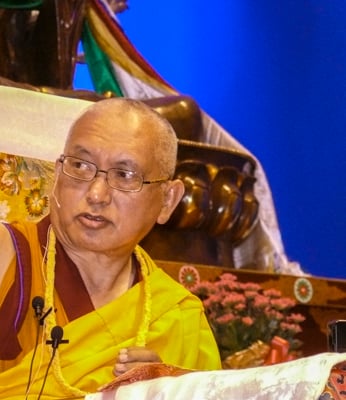 Lama Zopa Rinpoche offered his advice in the wake of the recent US election, suggesting that we make prayers for loving-kindness, compassion and bodhicitta to be generated in the hearts of the new leadership, and to continue to work on our own development of wisdom and compassion. You can read the entire advice on the FPMT website.
Lama Zopa Rinpoche offered his advice in the wake of the recent US election, suggesting that we make prayers for loving-kindness, compassion and bodhicitta to be generated in the hearts of the new leadership, and to continue to work on our own development of wisdom and compassion. You can read the entire advice on the FPMT website.
Also, even though the Thanksgiving holiday in the US has already passed, it is good to take Rinpoche's advice for Practices for Thanksgiving Day Turkeys and Remembering Gratitude.
Thank you again for your incredible support, and we leave you with this excerpt from the forthcoming book Abiding in the Retreat.
Much love,
Nick Ribush
Director
Lama Zopa Rinpoche: Why Everyone Should Recite om mani pAdme hum
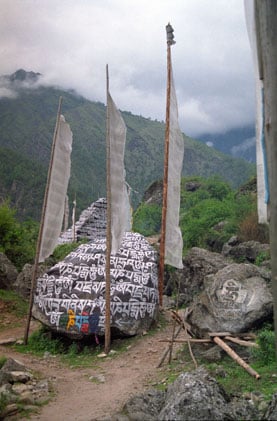 Meditation on Chenrezig and recitation of OM MANI PADME HUM are most important practices in your life. Concerning the happiness and benefit of other sentient beings, this is the most important practice to do in life; so there is no doubt concerning your own happiness and benefit. The meditation-recitation of Compassion Buddha is the most important thing.
Meditation on Chenrezig and recitation of OM MANI PADME HUM are most important practices in your life. Concerning the happiness and benefit of other sentient beings, this is the most important practice to do in life; so there is no doubt concerning your own happiness and benefit. The meditation-recitation of Compassion Buddha is the most important thing.
As I often say, because they want happiness and do not want suffering, even turtles, mosquitoes, ants and wood lice all need to recite OM MANI PADME HUM. Goats and pigs need to recite OM MANI PADME HUM, in loud voices. It’s the same for snakes—they also need to recite OM MANI PADME HUM. They should, but they can’t. Why not? Because they don’t have a human body. All animals should recite OM MANI PADME HUM, but they can’t. They should recite it because they want happiness and don’t want suffering. That’s why everyone should recite this mantra. It’s the easiest way to achieve happiness for yourself.
By reciting OM MANI PADME HUM, you can achieve all your wishes for happiness, not only for the happiness of this life but for the happiness of all your coming future lives, and then for ultimate happiness, with cessation of the oceans of samsaric sufferings and their causes, karma and delusions, and even their negative imprints. Cessation of all the negative imprints makes it impossible for delusions to arise again, which makes it impossible for negative karma to be accumulated, which makes it impossible for suffering to happen. There is then great liberation, or full enlightenment.
On top of that, you, the one person, want to bring other sentient beings the happiness of this life and of all their coming future lives, and the ultimate happiness of total cessation of the oceans of samsaric sufferings: the oceans of sufferings of the hell beings, the hungry ghosts, the animals, the human beings, the asuras, the suras and the intermediate state beings. You want to cause the cessation of the general sufferings of samsara and the particular sufferings of each realm; you want to cause everlasting happiness to the numberless sentient beings in each realm. You also want to bring them to full enlightenment, with cessation of not only the gross defilements but even the subtle ones. You want to bring them the complete qualities of cessation and of realization, which is full enlightenment. By chanting OM MANI PADME HUM, Compassion Buddha’s mantra, you can easily bring these four levels of happiness to the numberless sentient beings.
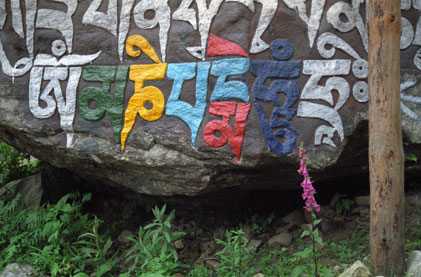 In essence, OM MANI PADME HUM includes all the Dharma, all the 84,000 teachings of Buddha, which comes in three levels: Hinayana, Paramitayana (Mahayana sutra) and Secret Mantra Vajrayana (Mahayana tantra). It’s a great mistake to say “Hinayana, Mahayana and Vajrayana,” as it makes it sound as if Vajrayana is not Mahayana teaching. This gives a completely wrong idea to the people who don’t understand; and you’re making a big mistake in front of the people who do understand, showing that you don’t know that Secret Mantra Vajrayana is Mahayana teaching.
In essence, OM MANI PADME HUM includes all the Dharma, all the 84,000 teachings of Buddha, which comes in three levels: Hinayana, Paramitayana (Mahayana sutra) and Secret Mantra Vajrayana (Mahayana tantra). It’s a great mistake to say “Hinayana, Mahayana and Vajrayana,” as it makes it sound as if Vajrayana is not Mahayana teaching. This gives a completely wrong idea to the people who don’t understand; and you’re making a big mistake in front of the people who do understand, showing that you don’t know that Secret Mantra Vajrayana is Mahayana teaching.
Vajrayana is practiced with bodhicitta. This is what makes Vajrayana teachings and practice Mahayana. Bodhicitta is fundamental. Without bodhicitta, Secret Mantra Vajrayana doesn’t become a cause of enlightenment. What makes an action or a teaching Mahayana is that it is done with bodhicitta. Without bodhicitta, Secret Mantra Vajrayana, even dzog rim or dzog chen, does not become Mahayana, does not become a cause of enlightenment.
And without renunciation of samsara, Vajrayana doesn’t become even a cause to achieve liberation from samsara for the self. Renunciation has two divisions: renunciation of this life and renunciation of future life samsara. Without renunciation of this life, Secret Mantra Vajrayana, even if you practice dzog rim or dzog chen, does not even become Dharma. Your practice of dzog rim or dzog chen without renunciation of this life, without letting go of the attachment clinging to this life, doesn’t even become Dharma, doesn’t even become virtue. It doesn’t even become a cause of the happiness beyond this life, the happiness of future lives. Besides not becoming a cause to be born in a pure land of buddha where you can become enlightened, it doesn’t even become a cause to achieve a good rebirth in your next life. Without renunciation of this life, the Secret Mantra Vajrayana you’re practicing, the dzog rim or dzog chen you’re practicing, doesn’t become Dharma. It becomes pure nonvirtue, leading to rebirth in the lower realms.
This is very much emphasized by Lama Atisha and the Kadampa geshes in the lam rim, and in the other traditions in texts such as The Words of My Perfect Teacher, the Sakyas’ Parting from the Four Clingings and Transformation of the Four Thoughts. It is explained in those preliminary, fundamental teachings.
Excerpted from Lama Zopa Rinpoche's Abiding in the Retreat, a nyung nä commentary, edited by Ailsa Cameron. Forthcoming from the Lama Yeshe Wisdom Archive in 2017.























